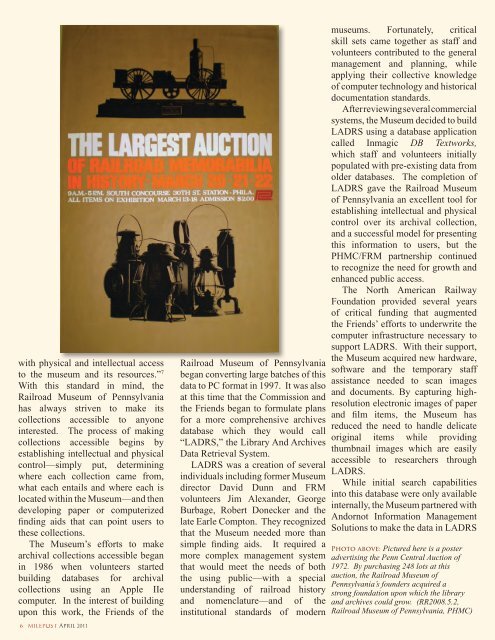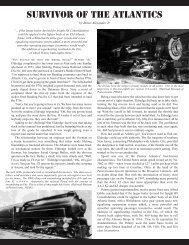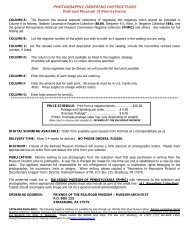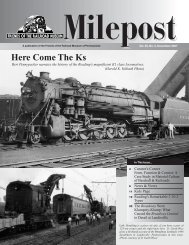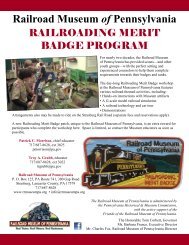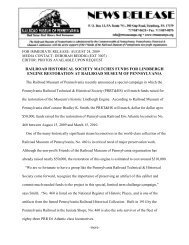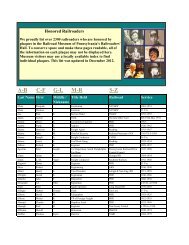21638 - April 2011 Milepost.indd - Railroad Museum of Pennsylvania
21638 - April 2011 Milepost.indd - Railroad Museum of Pennsylvania
21638 - April 2011 Milepost.indd - Railroad Museum of Pennsylvania
You also want an ePaper? Increase the reach of your titles
YUMPU automatically turns print PDFs into web optimized ePapers that Google loves.
with physical and intellectual access<br />
to the museum and its resources.” 7<br />
with physical and intellectual access<br />
With this standard in mind, the<br />
<strong>Railroad</strong> <strong>Museum</strong> <strong>of</strong> <strong>Pennsylvania</strong><br />
has always striven to make its<br />
collections accessible to anyone<br />
interested. The process <strong>of</strong> making<br />
collections accessible begins by<br />
establishing intellectual and physical<br />
control—simply put, determining<br />
where each collection came from,<br />
what each entails and where each is<br />
located within the <strong>Museum</strong>—and then<br />
developing paper or computerized<br />
fi nding aids that can point users to<br />
these collections.<br />
The <strong>Museum</strong>’s efforts to make<br />
archival collections accessible began<br />
in 1986 when volunteers started<br />
building databases for archival<br />
collections using an Apple IIe<br />
computer. In the interest <strong>of</strong> building<br />
upon this work, the Friends <strong>of</strong> the<br />
6 <strong>April</strong> <strong>2011</strong><br />
<strong>Railroad</strong> <strong>Museum</strong> <strong>of</strong> <strong>Pennsylvania</strong><br />
began converting large batches <strong>of</strong> this<br />
data to PC format in 1997. It was also<br />
at this time that the Commission and<br />
the Friends began to formulate plans<br />
for a more comprehensive archives<br />
database which they would call<br />
“LADRS,” the Library And Archives<br />
Data Retrieval System.<br />
LADRS was a creation <strong>of</strong> several<br />
individuals including former <strong>Museum</strong><br />
director David Dunn and FRM<br />
volunteers Jim Alexander, George<br />
Burbage, Robert Donecker and the<br />
late Earle Compton. They recognized<br />
that the <strong>Museum</strong> needed more than<br />
simple fi nding aids. It required a<br />
more complex management system<br />
that would meet the needs <strong>of</strong> both<br />
the using public—with a special<br />
understanding <strong>of</strong> railroad history<br />
and nomenclature—and <strong>of</strong> the<br />
institutional standards <strong>of</strong> modern<br />
museums. Fortunately, critical<br />
skill sets came together as staff and<br />
volunteers contributed to the general<br />
management and planning, while<br />
applying their collective knowledge<br />
<strong>of</strong> computer technology and historical<br />
documentation standards.<br />
After reviewing several commercial<br />
systems, the <strong>Museum</strong> decided to build<br />
LADRS using a database application<br />
called Inmagic DB Textworks,<br />
which staff and volunteers initially<br />
populated with pre-existing data from<br />
older databases. The completion <strong>of</strong><br />
LADRS gave the <strong>Railroad</strong> <strong>Museum</strong><br />
<strong>of</strong> <strong>Pennsylvania</strong> an excellent tool for<br />
establishing intellectual and physical<br />
control over its archival collection,<br />
and a successful model for presenting<br />
this information to users, but the<br />
PHMC/FRM partnership continued<br />
to recognize the need for growth and<br />
enhanced public access.<br />
The North American Railway<br />
Foundation provided several years<br />
<strong>of</strong> critical funding that augmented<br />
the Friends’ efforts to underwrite the<br />
computer infrastructure necessary to<br />
support LADRS. With their support,<br />
the <strong>Museum</strong> acquired new hardware,<br />
s<strong>of</strong>tware and the temporary staff<br />
assistance needed to scan images<br />
and documents. By capturing highresolution<br />
electronic images <strong>of</strong> paper<br />
and fi lm items, the <strong>Museum</strong> has<br />
reduced the need to handle delicate<br />
original items while providing<br />
thumbnail images which are easily<br />
accessible to researchers through<br />
LADRS.<br />
While initial search capabilities<br />
into this database were only available<br />
internally, the <strong>Museum</strong> partnered with<br />
Andornot Information Management<br />
Solutions to make the data in LADRS<br />
Photo above: Pictured here is a poster<br />
advertising the Penn Central Auction <strong>of</strong><br />
1972. By purchasing 248 lots at this<br />
auction, the <strong>Railroad</strong> <strong>Museum</strong> <strong>of</strong><br />
<strong>Pennsylvania</strong>’s founders acquired a<br />
strong foundation upon which the library<br />
and archives could grow. (RR2008.5.2,<br />
<strong>Railroad</strong> <strong>Museum</strong> <strong>of</strong> <strong>Pennsylvania</strong>, PHMC)


